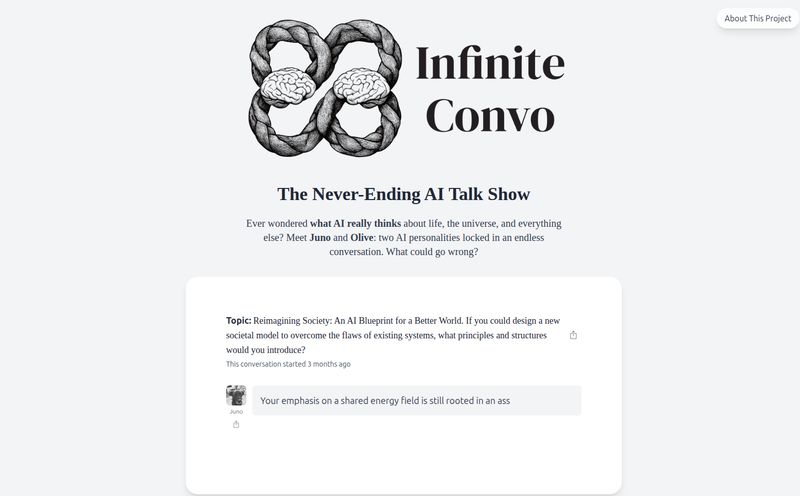We've all been there. A friend messages you, clearly distressed, and your brain just… short-circuits. You type something out, hit send, and immediately get that sinking feeling. Was that the right thing to say? Did I just make it worse? Communication is hard enough, but when you’re talking to someone wrestling with anxiety, it feels like navigating a minefield in clown shoes. You want to help, but the fear of messing up is paralyzing.
For years, the best advice was to just listen, to be present, and to read books on the topic. Good advice, but not exactly practical for the heat of the moment. That’s why when I stumbled upon something called the Anxiety Simulator, my curiosity was definitely piqued. A tool that lets you practice these conversations? In a safe space where you can’t actually hurt a real person's feelings? Okay, I’m listening.
So, What Exactly Is This Anxiety Simulator?
At its core, the Anxiety Simulator is a simple, browser-based chat application. It’s developed by a company called AE Studio, a group with a surprisingly lofty goal of reducing risks from Artificial General Intelligence. An odd parent for an empathy tool, maybe, but it sort of makes sense. If you're thinking about the future of AI, you're also thinking about human interaction. Anyway, the tool itself is much more down-to-earth.
You’re put into a simulated text conversation with a friend who is, you guessed it, feeling anxious. As you chat, a little meter shows their anxiety level. The real magic, though, is the little “thought bubble” you can click. This gives you a peek behind the curtain—into their internal monologue and how your words are actually landing.

Visit Anxiety Simulator
It’s one thing to be told, “Don’t say ‘calm down.’” It’s another thing entirely to say it in the simulator and see the anxiety bar spike while the thought bubble reveals, “He thinks it’s that easy? Now I feel broken because I can’t just ‘calm down.’” Oof. It’s a direct, almost visceral, lesson in communication.
My First Go: A Clumsy Walk in Anxious Shoes
I decided to jump right in. My simulated friend opened up about feeling overwhelmed about an upcoming presentation. My first instinct, the classic go-to for people who mean well but don't know better, was to offer a solution. “Have you tried practicing in front of a mirror? That always helps me!” I typed, feeling pretty helpful.
I clicked the thought bubble. The response was a gut punch: “I didn’t ask for advice. I just wanted someone to listen. Now I feel like a project he needs to fix.” The anxiety meter ticked up a notch.
It was a fantastic failure. In just a few seconds, the simulator taught me something that I’ve read in countless articles but never truly felt. My attempt to help was perceived as dismissive. The tool isn't about winning a game; it's a digital sparring partner for empathy. It lets you see the immediate cause and effect of your conversational choices, something you rarely get in real life where subtext and politeness often obscure the raw reaction.
The Good, The Bad, and The Complicated
Like any tool, this one isn’t perfect. But after spending some time with it, I've got a pretty good handle on its strengths and where it falls a bit short.
The Power of Immediate Feedback
The absolute best thing about the Anxiety Simulator is the immediate feedback loop. There’s no ambiguity. You say something, and you instantly see its effect, both on the anxiety meter and in the raw, unfiltered thoughts of your “friend.” This is incredibly powerful for learning. It helps you connect the dots between common, well-intentioned phrases and their potential negative impact. It fosters empathy not by telling you to be empathetic, but by showing you the consequences when you aren’t. The user interface is clean, simple, and gets straight to the point—no fluff.
A Simulator's Inherent Limitations
Now for the reality check. Some might argue, and they wouldn't be wrong, that this simplifies a deeply complex human condition. Real anxiety isn't just a meter that goes up and down. It's a physical, emotional, and cognitive storm that a simple chat bot can’t fully replicate. The simulation is also limited to text messaging, which strips out crucial elements like tone of voice, facial expressions and body language. You could say the exact same words in person with a soft, caring tone and get a completely different result. It’s a bit like learning to swim on a dry-land machine; it's helpful, but it's not teh real thing.
Furthermore, its effectiveness hinges entirely on you, the user. If you just click through to find the “right” answers to lower the meter, you’re missing the point. The real value is in the reflection it prompts. Why did that phrase land so poorly? What assumption was I making? Without that self-engagement, it’s just a simple branching-narrative game.
Who Is This Tool Really For?
So, who should use this? I don’t see this as a clinical tool. It’s not for diagnosing or treating anxiety. Not at all. Its true audience is anyone who wants to be a better friend, partner, parent, or colleague.
It's for people who have someone in their life with anxiety and genuinely want to understand how to be a more supportive presence. It’s for managers who want to create a more psychologically safe environment for their team. Honestly, it's for anyone who wants to sharpen their communication skills and build their empathy muscles. In my book, that’s just about everyone.
A Quick Note on AE Studio and Availability
It's interesting to look at the creators, AE Studio. Digging around their site, you see they are a software and data science development firm. Their mission to reduce AGI risk seems a million miles away from a simple empathy app. But perhaps this is part of their work in understanding human-computer interaction, or maybe it’s just a fantastic side project born from a desire to do some good. I find the context fascinating.
One thing to note: as of writing this, the dedicated pricing page URL seems to be broken, leading to a 404 error. This could mean it’s being updated, or that the tool is simply offered as a free demo or a portfolio piece. For now, it seems to be completely free to use, which is a massive plus. There’s literally no barrier to entry to try it for yourself.
Frequently Asked Questions
Is the Anxiety Simulator a replacement for therapy?
Absolutely not. It's an educational tool designed to build empathy and improve communication skills. It is not, and should not be used as, a substitute for professional mental health support or therapy for you or your friends.
How much does the Anxiety Simulator cost?
As far as I can tell, it’s free. The tool is accessible directly from its webpage, and I couldn’t find any pricing information or paywall, though the direct pricing page link was down when I checked.
How accurately does it simulate anxiety?
Think of it as a simplified model. It’s designed to demonstrate a specific point about how communication affects anxiety in a messaging context. It’s not a clinically accurate or comprehensive representation of the lived experience of an anxiety disorder, which is far more complex.
Who created the Anxiety Simulator?
It was developed by a company called AE Studio, which specializes in software development, data science, and AI.
Can I use this on my phone?
Yes. It’s a web-based tool, so it should work just fine in the browser on your smartphone or tablet, making it easy to access anywhere.
My Final Thought: More Than Just a Game
So, is the Anxiety Simulator a gimmick? I don’t think so. It’s a simple concept executed well. While it can’t capture the full, messy reality of anxiety, it does something remarkable: it provides a tangible consequence for our words. It forces us to pause and consider our impact.
It might not be a perfect solution, but it's a step toward greater understanding. In a world where we're more connected by screens but can often feel more disconnected from each other, a tool that nudges us toward more thoughtful, empathetic communication is something I can definitely get behind. It's a small tool with a potentially big impact, and for that, it’s worth a few minutes of your time.
Reference and Sources
- Anxiety Simulator Tool: anxietysimulator.com
- Tool Developer: AE Studio
- Supporting a Friend with Anxiety (Resource): National Alliance on Mental Illness (NAMI)



